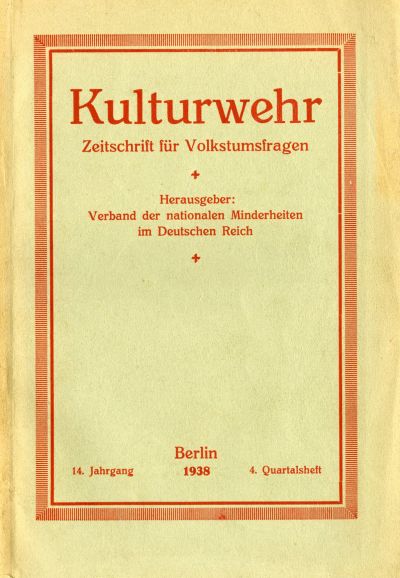“Kulturwehr”

At the end of the First World War there were many different national minorities in Germany. The largest group were the Poles (1,300,000 - 1,800,000): after that came the Sorbs (160,000–180,000). They were followed by the Czechs (ca. 45,000–50,000), the Danes (ca. 20,000), the people of Friesland (14,000–16,000) and the Lithuanians (15,000–18,000). There was a great difference in the legal situation of the national minorities in Germany. The status of the German minority in Europe was regulated by the norms of international law. However minorities living in Germany did not enjoy such a status and this had a great effect on their situation. It was clear from German policies that they considered national minorities to be a danger to the integrity of the state.
On the other hand German minorities were proof of the injustice Germany had suffered when national borders were redrawn as a result of the Treaty of Versailles, and that Berlin should be supported in its efforts to have the treaty revised. The German minority abroad was regarded as an integral part of the German nation and should therefore have minority rights. The national minorities living within the borders of Germany should be prepared to assimilate quickly. For this reason they should reckon with a restriction of national rights. In order to resist these hostile policies the minorities were forced to create common forms of organisation. Only in this way would they be able to articulate and defend their interests, and persuade the German majority of their rights. The first attempt to found such an organisation were taken as early as 1922 on the initiative of the Union of Poles in Germany.
The speech given by Jan Baczewski to the Prussian parliament in June 1923 is often seen as the founding moment of the later Union of National Minorities in Germany. In it he defended the Danish minority against the accusations of the German National People's Party that they displayed a lack of loyalty to the German state. In the following months discussions took place with representatives from the different minorities, and these often entailed setting aside mutual antipathies like those between the Poles and the Czechs. On 26th January 1924 a congress of minorities living in Germany (organised by the Union of Poles in Germany) took place in Berlin. It was attended by Poles, Danes, Sorbs, Czechs and representatives from Friesland, but despite all efforts to the contrary the invitation was ignored by the Lithuanians. During the congress the “Union of National Minorities in Germany” was set up.
The Prussian MP and first president of the Union of Poles in Germany, Stanislaw Sierakowski (after he stepped down from this post in 1934 he was succeeded by the Dane Ernst Christiansen) was elected as President. Over the next few years the Union strived to preserve the rights of minorities and enforce them in political and social matters. It also attempted to get representatives onto national and regional committees. The Union opposed the Germans’ instrumentalisation of minorities in their efforts to revise the Treaty of Versailles. It did not want to be politicised and regarded itself rather as an element in stabilising the domestic situation. Hence the Union strongly resisted Germany’s attempts to internationalise the minority question: it respected the legal system of the Weimar Republic and the Treaty of Versailles.
The Union’s publicity organ in which it could propagate its policies was the monthly “Kulturwille” (from 1925 “Kulturwehr”). Its editor-in-chief was Jan Skala, a journalist, writer and politician from Upper Lusatia: and the owner and publisher was the president of the Union, Stanislaw Sierakowski. The monthly soon became an important forum in which minorities could exchange their ideas and experiences. It provided a stream of information on questions concerning minorities in Germany and German national policies. In addition it supported candidates from minorities in their efforts to become elected to representative committees. In August 1924 a memorandum on the school system of Sorbs and Danes was laid before the German authorities, and in September 1977 a bill was presented to regulate minority school systems. From the start of the 1930s the monthly was dominated by information on the Nazi's failure to comply with the rights of minorities. On 5th November 1937 a delegation from the Union of Poles in Germany had an audience with the Nazi Chancellor Adolf Hitler to discuss the recent introduction of a minority decree (after the Upper Silesia agreement had expired). During the meeting they took the opportunity to present him with a copy of “Kulturwehr” along with some additional material. Some years later the journalist and editor of the “Młody Polak w Niemczech” (The Young Pole in Germany), Edmund Jan Osmańczyk recalled that the delegates “noted Hitler's explanation in silence. They then presented Hitler with seven thick volumes: the first contained the petition of the Union of Poles in Germany to the Chancellor of the Reich, which described in great detail the exceptionally difficult situation of Poles living in Germany. The remaining six volumes, all in small print, comprised no less than 3000 pages including a special edition of ‘Kulturwehr’ containing a selection by the legal office of the Union of Poles in Germany of hundreds of descriptions of Gestapo terrorist acts against Poles and Polish organisations (…)”. The material was subsequently handed over to foreign journalists and made available in libraries all over the world.
The editors required immense civil courage to publish the journal. In 1936 the Nazi authorities forced the resignation of the editor-in-chief (he was banned from practicing journalism) and the President of the Union, Stanislaw Sierakowski, was forced to leave Germany. The final edition of “Kulturwehr” appeared in 1938.
Krzysztof Ruchniewicz, April 2014

